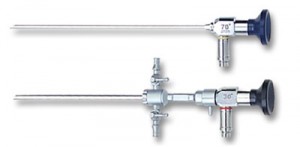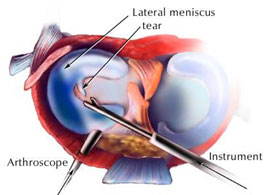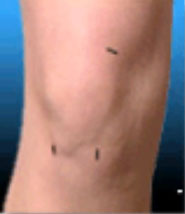What is Arthroscopy?
Arthroscopy (derived from words ‘arthros = joint’ and ‘scopein = to look inside’) is a procedure used to visualize the inside of a joint. An instrument called the arthroscope is used. Arthroscope is a telescope which is illuminated using an external light source. It provides a magnified image of the inside of joint on a video monitor. The diameter of an arthroscope varies from 2.7mm to 4mm depending upon the joint which is to be visualized. Arthroscopic surgery can thus be described as endoscopic (key-hole) surgery of the joints.
A 700 arthroscope (above) and a 300 arthroscope with its sheath
Arthroscopic surgery is a minimally invasive surgical procedure performed using small stab incisions (also called portals) about 5mm in size. Usually 2 or 3 portals are used depending upon the procedure being performed. The surgery is performed using a continuous irrigation (flow) of normal saline. Arthroscopic surgery is performed for diagnosis as well treatment of a variety of conditions (like cartilage and ligament tears) involving different joints like. Arthroscopic surgery is also termed as ‘Ligament and Cartilage Restoration Surgery’. At the present time arthroscopic surgery is commonly performed for the knee, shoulder, ankle, elbow, wrist and the hip joint.
Arthroscopic view of the knee joint Skin incisions used for knee arthroscopy
Advantages of Arthroscopic Surgery
Arthroscopic surgeries are considered to be ‘high yield surgeries’ considering the high rates of success and low rates of complications. The advantage of arthroscopy over traditional open surgery is that the joint does not have to be opened up fully. Instead, only two small incisions are made – one for inserting the arthroscope inside the joint and one for inserting surgical instruments. This significantly reduces the tissue trauma from the surgery which in turn results in faster recovery and return to work. It also reduces the hospital stay. It is especially useful for professional athletes, who frequently injure their joints and require faster healing time. There is also less scarring because of the smaller incisions. The surgical instruments used are smaller than traditional instruments.
What type of anaesthesia is required for arthroscopic Surgery?
Usually some form of anaesthesia is required for arthroscopic surgery. It can be performed under a general anaesthesia, spinal or epidural anaesthesia or under a regional block (nerve block) depending upon the nature of the surgical procedure to be performed and the preference of the anaesthetist and the patient.
Can arthroscopic surgery be performed as a day care procedure?
A number of arthroscopic surgeries can be performed as day care procedure. This depends upon the nature of the surgical procedure undertaken and the general condition of the patient.
Are there any risks and complications associated with arthroscopic surgery?
Arthroscopic surgeries are generally thought of as being “risk free” surgeries. The rate of complications following arthroscopic surgery is very low mainly due to the minimally invasive nature of the procedure. The possible complications are as follows:
1. Infection
2. Deep vein thrombosis (DVT)
3. Reflex Sympathetic Dystrophy (RSD) / Algodystrophy
4. Synovial fistula
Infection can follow any surgical procedure. However infection rates after arthroscopic surgery are extremely low. This is mainly because of the minimally invasive nature of surgery which allows the surgery to be performed with minimal trauma to the tissues. In the eventuality of an infection occurring, this can be easily treated. Infection limited to the skin (portal site infection) will respond well to antibiotics given intravenously or orally. Infection involving the joint will need a joint washout which can be performed as an arthroscopic procedure followed by antibiotic therapy for 4-6 weeks.
Deep vein thrombosis (clot formation in the leg veins) is again rare after arthroscopic surgery due to minimal tissue trauma as well faster return to activity after arthroscopic surgery as compared to open surgery. In patients who are considered to be at a higher risk of developing clots, prophylactic (preventive) anticoagulant therapy (blood thinning medication) in the form of low molecular weight heparins and graduated compression stockings (TED stockings) may be started in the early post-operative period. Patients with established clots in the post-op period will need Heparin injections for a few days followed by Warfarin tablets for about 3 months post-op.
Reflex sympathetic dystrophy (RSD) / Algodystrophy is a condition caused due to some malfunction of the autonomic nervous system (which controls a number of involuntary functions in the body). The exact nature and cause of this condition is still not very clear but it is known to occur after any injury or surgery of the limbs. It is associated with pain which gets aggravated with any touch sensation as well as with hot and cold temperatures in the surroundings. It is also associated with sensation of warmth in the affected limb and excessive sweating. Treatment of RSD involves rest, supervised physiotherapy, medication to control pain, specific medication like alpha blockers and occasional nerve blocks (injections to block the affected nerves temporarily). These symptoms almost invariably subside though it may take a few months.
Synovial fistula is again an extremely rare complication following arthroscopy. It is due to delay in the healing of the portal (small cut) made in skin. This leads to some oozing (discharge) of fluid from the joint. Most of these will eventually heal by itself. Sometimes it may need a small surgical procedure to repair the fistula.


